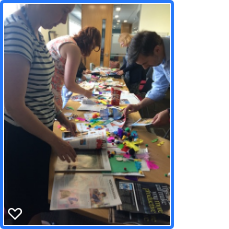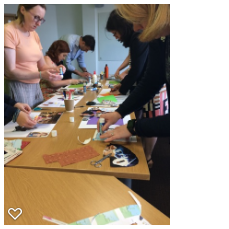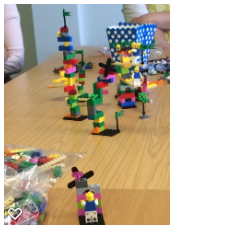
This year, CEL have facilitated workshops focused on the knowledge-making potential of creative processes. Students, even if they are hesitant at first, appreciate the time to think, process and create something. These approaches can be adapted from short five minute bursts of activity to longer pieces of collaborative work. Examples include the use of collage, origami, drawing, lego, and paint, to name a few. What is inherent to all of these are the potential metaphoric capacities and the strong ownership felt towards their creations. Students become enthralled by whatever they are making and the process of ‘play’ in HE to conceptualise, deconstruct and re-shape viewpoints is gaining momentum in Higher Education. This year we have run collage and drawing workshops for GP trainees, several Lego workshops and two Origami workshops. CEL can create bespoke sessions with teams.
In CELebrate2018, we ran two sessions: the morning session was dedicated to visual media of images and collage and the afternoon session to Lego both of which have been used in large group settings.
In the morning, Curie Scott started with a very quick ice-breaker technique using Evoke cards, asking participants to pick an image that represented their experience of being a particpant in a large group setting. Of course, you can create a set of your own photographs or ask people to use photos from their own device. Padlet is an excellent way for either individuals or groups to gather images to produce a summary of responses and capture the discussion. We then moved on to collages. Collages are considered by some as a style of drawing – the assembling of ready made magazine images is often much more comfortable than being invited to draw. Adults may not have created a collage since childhood unless they have used the process with children themselves. We used the prompt of “what would be the best large group teaching experience.” Prior to this prompt, participants spent 10 minutes collecting images they were particularly drawn to before focusing on the prompt. These images were then glued onto A3 heavy weight paper. A few people were invited to share the meaning of their collage – in facilitated sessions this can be done in pairs, individually or by inviting volunteers to share to the whole group. Of course, this depends on how personal the original prompt is. It is valuable for facilitators to be aware that working with images can facilitate the surfacing of emotional matters as analogic associations are readily made.


In the afternoon Susanne Clark led a session on Lego. Firstly, there was time to orientate to handling Lego, where each participant built a tower to represent their week. This then moved to building a structure about using lego for reflection, a key requirement in many courses. When we build a conceptual structure there are numbers metaphors based on colour, shape, trajectory and structure that are multi-faceted. Using Lego and other 3D modelling processes can help people see, acknowledge and share their reflections in an easier way than the use of words alone.
We have two workshops coming up, come and join us!!








